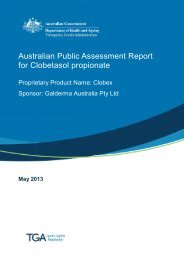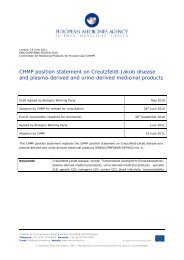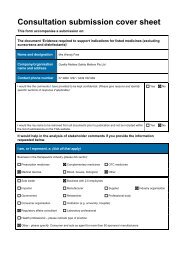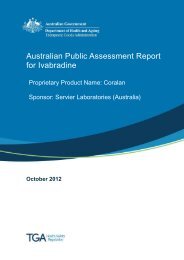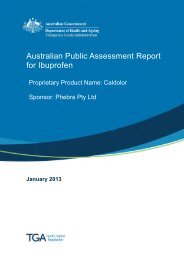AusPAR: Cabazitaxel - Therapeutic Goods Administration
AusPAR: Cabazitaxel - Therapeutic Goods Administration
AusPAR: Cabazitaxel - Therapeutic Goods Administration
Create successful ePaper yourself
Turn your PDF publications into a flip-book with our unique Google optimized e-Paper software.
Stability<br />
<strong>AusPAR</strong> Jevtana <strong>Cabazitaxel</strong> Sanofi-Aventis Australia Pty Ltd PM-2010-02565-3-4<br />
Final 9 February 2012<br />
<strong>Therapeutic</strong> <strong>Goods</strong> <strong>Administration</strong><br />
There is precipitation in the concentrate in vials stored at 5ºC with formation occurring in<br />
all three batches after 6 months. This was attributed to polysorbate 80, not cabazitaxel,<br />
but “Do not refrigerate” was recommended.<br />
The stability of the prepared infusion solution was also investigated, including the<br />
extraction of DEHP. Polyurethane infusion sets gave significant assay declines<br />
(presumably due to drug adsorption). Crystallisation was seen under some storage<br />
conditions outside the recommended label conditions. The PI recommends against PVC<br />
infusion containers (bags or bottles) and polyurethane infusion sets (tubing, filter,<br />
pumps): it may be desirable to include positive recommendations.<br />
Other aspects<br />
Container safety, sterility and endotoxin aspects were all evaluated to the satisfaction of<br />
the TGA.<br />
Biopharmaceutics<br />
It has been reported that non-ionic surfactants such as polysorbate 80 influence the<br />
disposition of solubilised drugs that are administered intravenously. It has also been<br />
reported that there is reduced cellular uptake of the drug from the micelles which act as<br />
the principal carrier of circulating drug, which alters drug accumulation in erythrocytes. 4<br />
No bioavailability or pharmacokinetic data were reviewed by the quality reviewer as is<br />
normal practice for intravenous solutions.<br />
Advisory Committee Considerations<br />
The application was reviewed at the 139th and 140th meetings of the Pharmaceutical<br />
Subcommittee (PSC) of the Advisory Committee on Prescription Medicines (ACPM).<br />
Provided outstanding issues were addressed, there were no objections to registration.<br />
Issues to be resolved at the time related to finished product specifications, sterility and<br />
Good Manufacturing Practice.<br />
Quality Summary and Conclusions<br />
Outstanding issues were resolved and there was no objection to registration.<br />
III. Nonclinical Findings<br />
Introduction<br />
The overall quality of the submission was good. <strong>Cabazitaxel</strong> was well characterised, with<br />
relevant aspects of the drug being investigated. With occasional exceptions<br />
(predominantly in the primary pharmacology section), studies were well conducted and<br />
reported. Where relevant, studies were Good laboratory Practice (GLP) compliant and<br />
were preceded by dose range finding studies in order to select appropriate dose levels.<br />
Pharmacology<br />
Primary pharmacodynamics<br />
Mechanism of action<br />
Like docetaxel and paclitaxel, cabazitaxel was shown to promote the assembly of tubulin<br />
(purified from porcine brain) into microtubules and to inhibit microtubule disassembly<br />
4 Ten Tije AJ, VerweijJ, Loos WJ, Sparreboom A. Pharmacological effects of formulation vehicles:<br />
Implications for cancer chemotherapy. Clin Pharmacokin 2003; 42: 665-685.<br />
Page 8 of 75





